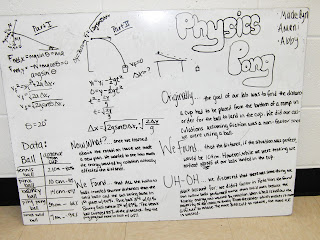- This group created a mostly empirical model relating the height to which an air track glider would rebound off of an elastic bumper, based on the height from which it was released. They created a model of the "effective friction coefficient" based on the data, though they realized about halfway through that the bumper's probably the show, and that, with some more data, they could investigate the energy loss in the bumper as a function of v.
- This group predicted how far a block would slide down a ramp (slowed by friction and a spring) before it stopped and was stuck by static friction.
Here are some "before" and "after" pictures: it was a pretty good prediction!
- This group found the difference in the average force delivered with a "poke" and with a "flick" to a cart tethered by two springs.
- This group predicted where a ball would land after rolling down a ramp and falling off of a table. Their results were interesting: all were short, but the smallest solid balls were the best. They made a surprising conclusion about rotational kinetic energy, which they hadn't even known existed before today!
The balls' landing positions, with the roll of tape being the target:
- This group also tried a "ramp and hit the target" experiment. They slid a mass down the ramp and tried to land in the foam catch box.








No comments:
Post a Comment